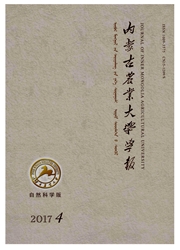

 中文摘要:
中文摘要:
本研究以数理统计为工具,在内蒙古典型草原地带的羊草+大针茅(Leymus chinensis+Stipa grandis)样地,对4种代表性植物羊草(Leymus chinensis)、大针茅(Stipa grandis)、米氏冰草(Agropyro michnoi)、冷蒿(Artemisia frigi-da)单珠生物量的动态变化与各气象因子的相关性进行了研究。运用逐步回归分析法,确定了主要水热环境参数,建立了植物生物量与主要气象因子累积关系的Logistic生长模型,分别对4种植物生长特征进行了模拟和比较。结果表明:(1)降水和积温因子对4种植物生物量的形成都是重要的影响因子,但降水较积温因子的影响更大(r12,3〉r13,2 R21(2)〉R21(3))。(2)同一气象因子对不同植物生物量的影响有差异,降水对4种植物影响的重要性次序为:羊草(0.964)〉米氏冰草(0.937)〉大针茅(0.928)〉冷蒿(0.906) 积温因子影响的重要性次序为:羊草(0.918)〉大针茅(0.909)〉米氏冰草(0.875)〉冷蒿(0.754)。(3)植物单株生物量随降水量变化、积温变化的潜在最大值一致表现为:冷蒿〉大针茅〉羊草〉米氏冰草,说明冷蒿具有较大的产量潜力。
 英文摘要:
英文摘要:
It was studied that correlations of meteorological factors and growing dynamic of the individual biomass of plants based on mathematical statistics in this paper. The representative plants were selected in different degeneration stages in the sample of Leymus chinensis + Stipa grandis in the typical steppe of Inner Mongolia. These plants were L. chinensis, S. grandis, A. michnoi and A. frigi- da. Environmental Specifications of water and heat were determined and Logistic growth model of cumulative relation of plant biomass and meteorological factors was established by application of the stepwise regression. And the characteristics of four plants were simula- ted and compared. The results showed: (1) Precipitation and accumulated temperature were the important factors influencing the bio- mass of four plants, and the effect of precipitation is greater than that of accumulated temperature on biomass of four plants. ( r12,3 〉 r13,2;R21(2) 〉 R21(3) ) . (2)The effects of same meteorological factor on biomasses of different plants were different. The effect of precipitation on four plants was L. chinensis (0.964) 〉 A. michnoi (0. 937) 〉 S. grandis (0.928) 〉 A. frigida (0.906) ;and effect of accumulated temperature on four plants was L. chinensis(0. 918) 〉 S. grandis(0. 909) 〉 A. michnoi(0. 875) 〉 A. frigida(0. 754) . (3)The potential maximum change of the individual biomass with the changes of precipitation, accumulative temperature was A. frigida 〉 S. grandis 〉 L. chinensis 〉 A. michnoi, which meant A. frigida has the maximum yield potential among the four species.
 同期刊论文项目
同期刊论文项目
 同项目期刊论文
同项目期刊论文
 期刊信息
期刊信息
